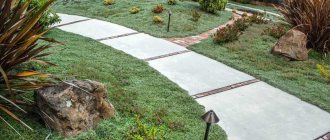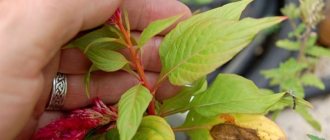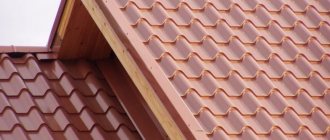Soft (flexible) roofing is a durable, reliable roofing covering. Like any material, it has certain advantages, technical characteristics and installation features. It is due to the combination of such differences that soft roofing is actively spreading at any facility.
Flexible bitumen shingles
Composition and structure of soft roofing
Soft roofing is the general name for various types of roll coverings for “flat” and “pitched” roofs, as well as flexible (bitumen) tiles, which are used as a roofing covering only for “pitched” roofs. Manufacturers of bitumen shingles produce a wide range of items with different compositions, different shapes, and differences in appearance. The choice of specific roofing material depends on the required service life and appearance preferences.
Soft roof structure
Ruflex bituminous (flexible) tiles are produced in the form of piece sheets - shingles with figured cutouts that imitate the pattern of ceramic tiles. The structure of bitumen sheets from almost all manufacturers is the same:
- The base is fiberglass (non-woven fiberglass) impregnated on both sides with modified bitumen. In its composition, polymer modifiers are added to bitumen resins, which provides increased strength and flexibility of the material. Fiberglass gives the shingles the desired shape and prevents them from deforming when heated in the sun,
- the outer front decorative and protective layer is coated with basalt or slate chips. Colored granules give the tiles different shades and texture of the coating, and also protect the surface from mechanical stress, ultraviolet rays and other aggressive environmental factors,
- the lower back layer is covered with fine-grained sand and rubber-bitumen glue (for strong fixation of the petals and reliable waterproofing) - with a protective polymer film that protects the shingles from sticking during packaging and is removed before installation.
Structure of Ruflex soft roof
What to consider when choosing?
You need to start with the base, this applies to any type of soft roof, and in the case of flexible tiles - from fiberglass. It must have a density of at least 100 g per square meter, because this indicator determines how much bitumen the soft roof can absorb. The more, the more reliable and durable the material.
As for bitumen, we discussed its types above. Choose one that will provide the best performance in your conditions.
The topping or granulate is made from slag, coarse river or sea sand, shale or basalt chips. Experts consider the latter option preferable for soft roofing, because basalt chips are hot-painted, which ensures color fastness, and have a particle shape that prevents them from falling off.
During transportation and installation, flexible tiles should not lose more than 1.2 g of stone dressing per shingle.
Design is a purely individual issue, but it greatly influences the final cost of the roof. There is only one piece of advice here: since you are going to use a roofing material that will last for many years, choose one that you like.
The number of layers is a factor that has a decisive influence on costs. The thicker the material, the heavier it is. This means that it is more expensive to install, it is more difficult to prepare the base, and the roof must withstand such weight.
The photo shows a three-layer gray-brown soft tile with Brix-type shingles, surprisingly similar to natural stone plates
Advantages and disadvantages of soft roofing
- versatility and elasticity - the ability to be used for installation on roofs of various configurations with a suitable design for the overall design style of a house (building) made of wood, brick or with siding. It is soft tiles that are optimally suited for installation on conical, hipped or multi-level roofs, since flexible sheets are able to take the desired shape,
- light weight of sheets (8 - 10 kg per 1 sq.m.) - no additional reinforcement of structural elements and rafter system is required. It is also convenient to carry out installation in the shortest possible time,
- wide range of colors and different shapes of shingles,
- durability - if all conditions for laying a soft covering are met, the roof is regularly maintained - the service life of the material is up to 50 years,
- completely sealed and waterproof,
- excellent sound insulation - absorbs the noise of rain or hail, external sounds are barely perceptible indoors,
- surface roughness – snow masses evenly accumulate on a soft roof and after a thaw they gradually melt, without presenting the danger of an avalanche. There is no mandatory requirement to install snow guards on the roof, as on smooth (metal) roofs,
- no corrosion or rust,
- ease of storage and transportation of soft roofing packages,
- relatively low price compared to other roofing materials,
- quick, simple installation and a small amount of waste when laying the coating,
- maintainability - the ability to replace individual damaged shingles on a general covering.
Variety of colors of Soft roofing
In addition to the listed advantages of bitumen shingles, the material also has some specific disadvantages that are important to consider when laying sheets and operating soft roofing:
- It is recommended to install shingles at a temperature not lower than +5°C,
- to lay soft tiles, it is necessary to prepare a flat, solid base and use an underlay waterproofing carpet, which increases the cost of the roof, but on the other hand adds structural strength,
- Debris (dry branches, fallen leaves) can accumulate on the rough surface of bitumen sheets; over time, moss can appear on the northern shady slopes, so it is necessary to periodically carry out a visual inspection and cleaning of the roof.
| pros | Minuses |
| Versatility | Installation is recommended to be done at +5°C |
| Light weight sheets | A flat surface is required for installation |
| Large selection of colors | Over time, moss may appear on the shadow slopes. |
| Durability | |
| Completely sealed and waterproof | |
| Resistance to temperature fluctuations | |
| Excellent sound insulation | |
| Surface roughness | |
| Ease of storage and transportation | |
| Excellent combination of price and quality | |
| Easy installation | |
| Maintainability |
Production
Natural ceramic tiles are made from ordinary pottery clay (Creaton, Erlus, Tondach). This natural mineral perfectly tolerates the effects of water and temperature changes. But pure clay is not flexible, so to give it elasticity, various synthetic substances are added to the powder. There are two options for the production of ceramic panels:
- Tape. The finished clay mixture is poured into a large flat mold, which is processed using pressure and high temperature. Afterwards, the resulting slab (or strip) moves along the rolling table and is cut. This production is characterized by high speed, so this type of tile production is most often used in factories;
- Stamping. This is a slightly different system. A large number of molds or stamps are used into which the clay mixture is poured. After pouring, it is processed in an oven. Next, the stamps are pressed. This allows you to create tiles with an interesting texture or unusual wave. Such tiles are more expensive than strip tiles, but they are distinguished by their beauty and durability.
Photo: ceramic tiles Robin
Another type of natural tile is cement-sand tile (Sea Wave, Irta, Coppo). Like clay, it has excellent technical characteristics and is environmentally friendly, but at the same time, it costs an order of magnitude cheaper than ceramic. Such roofing materials are made from a mixture of concrete and colored polymer pigments. Externally, these panels are practically indistinguishable from clay ones, but they are much cheaper. It should be noted that concrete and clay have almost identical compositions. The only difference is that clay must be fired in a kiln at a temperature of 1000 degrees to obtain high hardness, and concrete - 600.
Types of natural tiles:
- Flat or beaver tail. These are BRAAS, Bergamo and others. It is used for roofs with a slope of 35 degrees or more. It is characterized by a simple but easy-to-install design. But, at the same time, it has a significant drawback - cracks into which snow and water fall;
- The grooved one has a special device for draining water. Hidden fastenings are simple and easy to use. Can be used on both flat and pitched roofs;
- Wavy. Mainly used for roofs with a slight slope - up to 50 degrees. Unlike beaver tail, it has no cracks, which makes it highly airtight. It is considered the most popular type of natural roofing tiles.
Technical characteristics and types of soft roofing
The multilayer structure of Ruflex bitumen shingles ensures its high performance properties. The quality of the material complies with the European standard EN 544:
RUFLEX soft roofing is produced using modern high-tech equipment at factories in the USA, EU countries and Russia. The company's specialists have developed separate collections of bitumen shingles, which differ in appearance and price of the material.
Installation of end strips
Special end strips are attached to the ends of the roof. They are installed according to the same rules as cornices.
Design of a roofing “pie” for soft tiles
The arrangement of any roof consists of a sequence of certain layers and resembles a multi-layer “pie”:
- Top (finish) covering with soft tiles for basic waterproofing and aesthetic appearance,
- Underlay waterproofing carpet, for additional waterproofing,
- A continuous, level base for roofing made of plywood or OSB boards, it is recommended to lay it on lathing,
- A beam to provide a ventilation gap (at least 5 cm) is required only when installing insulated attic spaces to ensure free ventilation of the under-roof space
- Superdiffusion membrane,
- A layer of thermal insulation (rolls or mats), with a total thickness of at least 200 mm
- Vapor barrier film,
- Filing under the ceiling of the attic room.
Roofing pie for soft roofing
Installation of flexible tiles can be divided into 2 stages:
- preparatory work,
- laying soft covering.
Preparation for soft roofing
Installation recommendations
Before you look for everything you need for fasteners and start laying a soft roof, you need to prepare a reliable roofing pie, consisting of the following layers (from the inside out):
- vapor barrier - a polymer membrane that does not allow moisture, which is formed inside the house during human activity and household work, to penetrate the insulation;
- thermal insulation - usually a thick carpet of mineral wool slabs;
- waterproofing - polyethylene film, which protects the insulation from water leaks from the outside of the building as a result of precipitation;
- sheathing - a wooden structure necessary to provide ventilation and protection against condensation;
- base - sheets of plywood or edged boards;
- underlay carpet is a special material that is laid overlapping both longitudinally and transversely for subsequent installation of a soft roof.
Describing the process itself in words would take up a lot of your time and would hardly allow you to understand the details. It’s better to watch a video about how real craftsmen perform waterproofing work, carry out the final preparation of the roofing pie and laying the top materials.
Laying bitumen shingles
At this stage the following processes are performed:
- A solid flooring made of moisture-resistant plywood with a thickness of 9–11 mm or OSB boards (with a thickness of at least 9 mm), which do not bend and hold fasteners well, is mounted on the sheathing. Additionally, it is necessary to treat the prepared base with fire-retardant and water-repellent compounds, and then be sure to dry it - the base must be completely dry. A small joint of 2–5 mm is left between the plates for thermal expansion of the material. The absence of such a gap can lead to deformation of the base;
- laying underlay carpet - for additional waterproofing. It is important to prevent wrinkles from appearing on the coating and maintain the tightness of the installation. To do this, the roll is rolled out parallel to the eaves overhang or, if there is a large slope, perpendicularly. The canvases are laid with an overlap - 10 cm on the long side and 15 cm at the joints
- • In some cases, durable underlayment may be used as a temporary roof.
Each asphalt shingle manufacturer has a recommendation for choosing a specific brand of underlayment. The Ruflex company provides two types of self-adhesive bitumen-based underlay carpets - Ruflex and Ruflex Ultra. And also a durable synthetic underlay carpet consisting of 5 layers - Malarkey Secure Start Plus. Before fixing, any roll of carpet is well smoothed and stretched to eliminate waves and bubbles. They will not only greatly spoil the appearance of the coating, but can also contribute to the deformation of the shingles of flexible tiles. The rolls are fixed with roofing nails; - flexible tiles are laid directly on the underlayment in rows from bottom to top (from eaves to ridge). To attach the shingles, remove the protective film, lay the sheet with an adhesive layer and press it to the surface of the carpet. Then it is leveled and securely fixed with roofing nails. The tightness of the coating is achieved by overlapping the shingles and gluing the petals. In places where there is not enough adhesive layer, you can additionally use Ruflex bitumen mastic during installation. To eliminate the effect of different shades at the installation stage, it is recommended to take shingles from different packages in a chaotic order. Experienced installers recommend marking the shingles before laying shingles; this makes it much more convenient to record rows and pattern offsets.
Laying a soft roof
To install roofs, galvanized roofing nails with a wide head (diameter of at least 9.5 mm) are used:
- on slopes with an angle of up to 45° - 4 nails for each shingle of bituminous shingles,
- on slopes with an angle of inclination greater than 45° - 6 nails for each shingle of Ruflex tiles.
Nails for soft roofing
Carrying out calculations
The roof structure with metal tiles is a series of metal waves, which are made up of identical rows across the slope. This distance is called a step. Modern models of the material have different sizes of metal tiles. This applies to step width.
For example, if a sheet has dimensions of 36 cm and 6 identical waves, then it is called a module. In specialized departments of construction stores there is a large selection of metal sheets that have from 1 to 10 modules.
First of all, you need to calculate the maximum horizontal length of the wooden slope. To do this, you need to divide the available width of the metal sheet and round the resulting values up. As a result, it is possible to calculate the exact number of roofing rows.
During the construction process, it is recommended to take into account the overlap of metal sheets with each other. The photo of metal tiles shows popular product models.
Under-roof ventilation device
In the under-roof space, it is necessary to create conditions for free access of air by installing special ventilation valves. Natural or forced ventilation performs important functions that affect the life of the roof and the comfort of living in the house:
- removal of vapors and weathering of excess moisture due to air circulation,
- uniform temperature distribution in the under-roof space,
- cooling the roof in the summer heat, when the soft roofing becomes very hot.
In this case, regardless of the installation method, it is important to obtain:
- free movement of air flows,
- protection of the roof structure from precipitation (rain and snow),
- protecting the roof ridge from moisture,
- evaporation of excess moisture from premises.
In the process of installing ventilation in an insulated pitched roof, three main elements are distinguished:
- holes for air flow,
- channels above the thermal insulation layer for air circulation,
- exhaust openings in the upper part of the roof.
Installation of a ventilation system for soft roofs
For soft roofs, two types of ventilation devices are used:
- a ridge aerator with through vents, on which special ridge tiles are then laid,
- point aerators and passage elements. It is recommended to install small aerators at the rate of every 60 square meters. m of roofing, and large ones - for every 100 - 150 sq. m. m. The distance between elements should not exceed 12 meters.
Quite often it is recommended to design a combined ventilation system - installing ridge aerators in combination with additional point elements. This option allows you to protect the under-roof space as reliably as possible and organize an effective air exchange system.
When installing bituminous shingles, it is recommended to adhere to the following conditions:
- use high-quality materials for each layer of the roofing pie, since it is the multi-layer structure that ensures the long service life of the roofing covering,
- pay special attention to the design of valleys and roof passages in order to reliably protect these areas from leaks and the likelihood of moisture,
- on new roofs of built houses, the lining carpet is fixed on the entire surface of the base, and not just on individual zones,
- if you do not plan to dismantle the old waterproofing coating or roofing material from the roof, it is allowed to lay new shingles directly on top of it. The main thing is to make sure of the strength of the solid base and the stability of the rafter system,
- if you plan to lay shingles at air temperatures less than +5°C, packages of tiles should be placed in a warm room and gradually applied to the roof. The back of the adhesive layer may need to be heated with a heat gun for strong fixation.
Mansard roofs
Anthracite-colored shingles create the effect of a roofing carpet made of rectangular slate tiles and look great in combination with sandy ocher brick walls.
The attic roof of a private house is covered with bitumen shingles, imitating a slate roof made of octagonal tiles. The roof covering acquired a bright color thanks to the floral pattern.
The dark gray soft roof made of rectangular modules combines effectively with the copper trim of the attic dormers.
Features of soft roof repair
The need to repair flexible tiles arises in the event of deformation, mechanical damage to the material or its wear. Taking into account the integrity of the coating, the presence of cracks, and defects on the surface, routine roof repairs or complete replacement of the roofing material are carried out. The greater the number of damaged roof areas, the more time and financial costs will be required to eliminate them.
Experts identify several main reasons for repairing soft roofs:
- various damage to the material due to its poor quality,
- violation of the technology for installing multi-layer roofing pie,
- lack of regular and effective maintenance of the tile covering,
Partial or complete repair of flexible tiles is not recommended to be postponed for a long time in order to avoid sagging of the roofing covering and further destruction of the roof. According to the installation method, the process of restoring the roofing can be performed:
- replacing individual damaged shingles and sealing these areas,
To repair bitumen coatings, choose dry, warm (up to +20°C) weather.
The process of replacing individual shingles is carried out in the following sequence:
- bend the top row of tiles over the damaged element and carefully dismantle it (cut it with a sharp knife, removing roofing nails),
- then the base under the cut shingles is thoroughly dried and cleared of any accumulated debris. Apply bitumen mastic to this area to securely attach the new shingles,
- on the prepared area, glue a new shingle of flexible tiles into the joint, press it well and additionally fix it with roofing nails,
- then the top bent row of tiles is fixed back, if necessary, coating the back layer of the shingles with mastic,
- the repaired area with 2-3 adjacent rows of tiles is firmly pressed to the surface of the base and rolled with a roller for reliable fixation.
Soft roof repair
New shingles cannot simply be glued on top of existing ones, since distortion of the geometry can lead to cracks in the roofing.
- Leaks at the joints and abutments of the roof are eliminated by additionally sealing the seams with bitumen mastic and gluing the abutment with new material.
Types of material
The following types of flexible tiles are distinguished:
- ridge-cornice (designed for laying on the surface of ridges and cornices);
- private It should be noted that ordinary shingles can be cut in various types - rectangle, diamond, hexagon, brick, shingles, beaver tail and dragon tooth.
- single-layer flexible tiles;
- multilayer flexible tiles.
Comparison table with manufacturers
| A country | Country of Origin | min rub./m2 | max RUR/m2 | The basis | Bitumen binder | Top sprinkle | Roof angle | |
| Shinglas TechnoNIKOL | Russia | Russia | 260 | 1261 | fiberglass | oxidized, SBS-modified bitumen | basalt | 12° |
| ICOPAL | Finland | Russia | 450 | 695 | fiberglass | SBS modified bitumen | slate | 11,3° |
| CertainTeed | USA | USA | 705 | 3393 | fiberglass | SBS modified bitumen | stone pavement | 9,5° |
| Tegola | Italy | Italy, Russia | 287 | 772 | fiberglass | PM-modified bitumen | basalt | 12° |
| Katepal | Finland | Finland | 439 | 1045 | fiberglass | SBS modified bitumen | stone pavement | 11,5° |
| Dock | Russia | Russia | 287 | 473 | fiberglass | oxidized, SBS-modified bitumen | basalt | 12° |
| Ruflex | Russia | Russia | 343 | 579 | fiberglass | SBS modified bitumen | basalt | 11,3° |
To perform proper installation, you need to purchase the following components for soft roofing:
- OSB3 (OSP-3) is an oriented strand board with moisture resistance class 3. Designed for external construction work.
- Ridge-eaves tiles
- roofing nails
- Ridge aerator
- Snow stops for bitumen shingles
- Valley carpet
- Underlay carpets
- Mastic
- Metal strips











